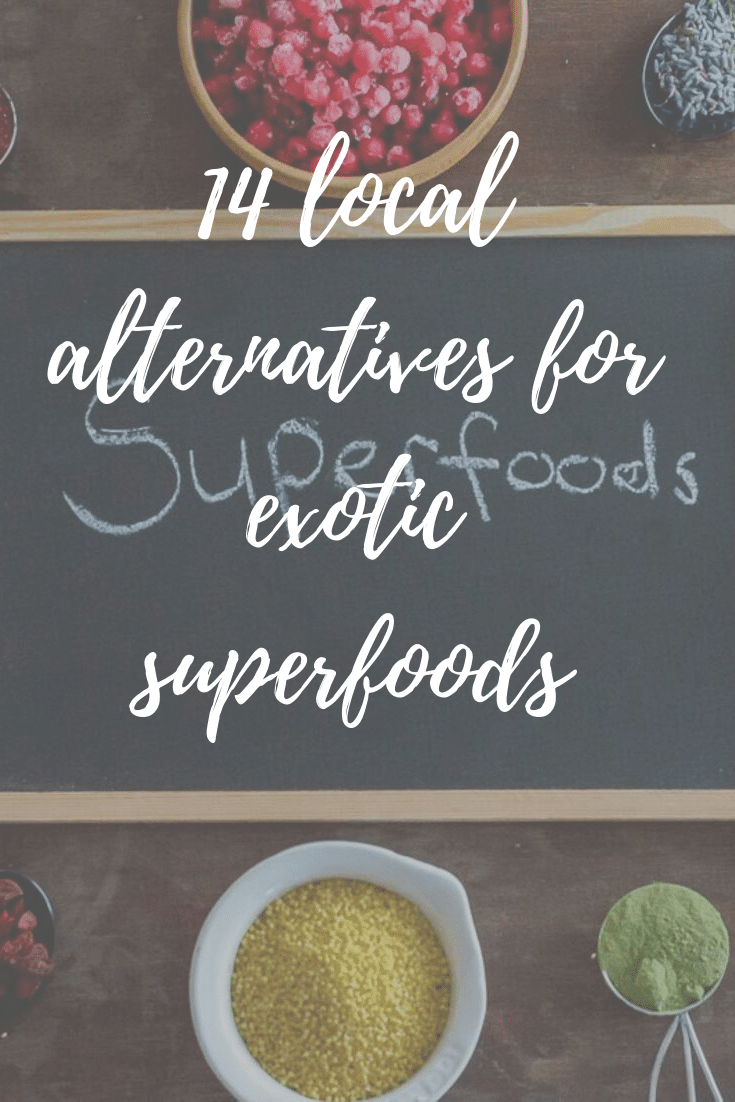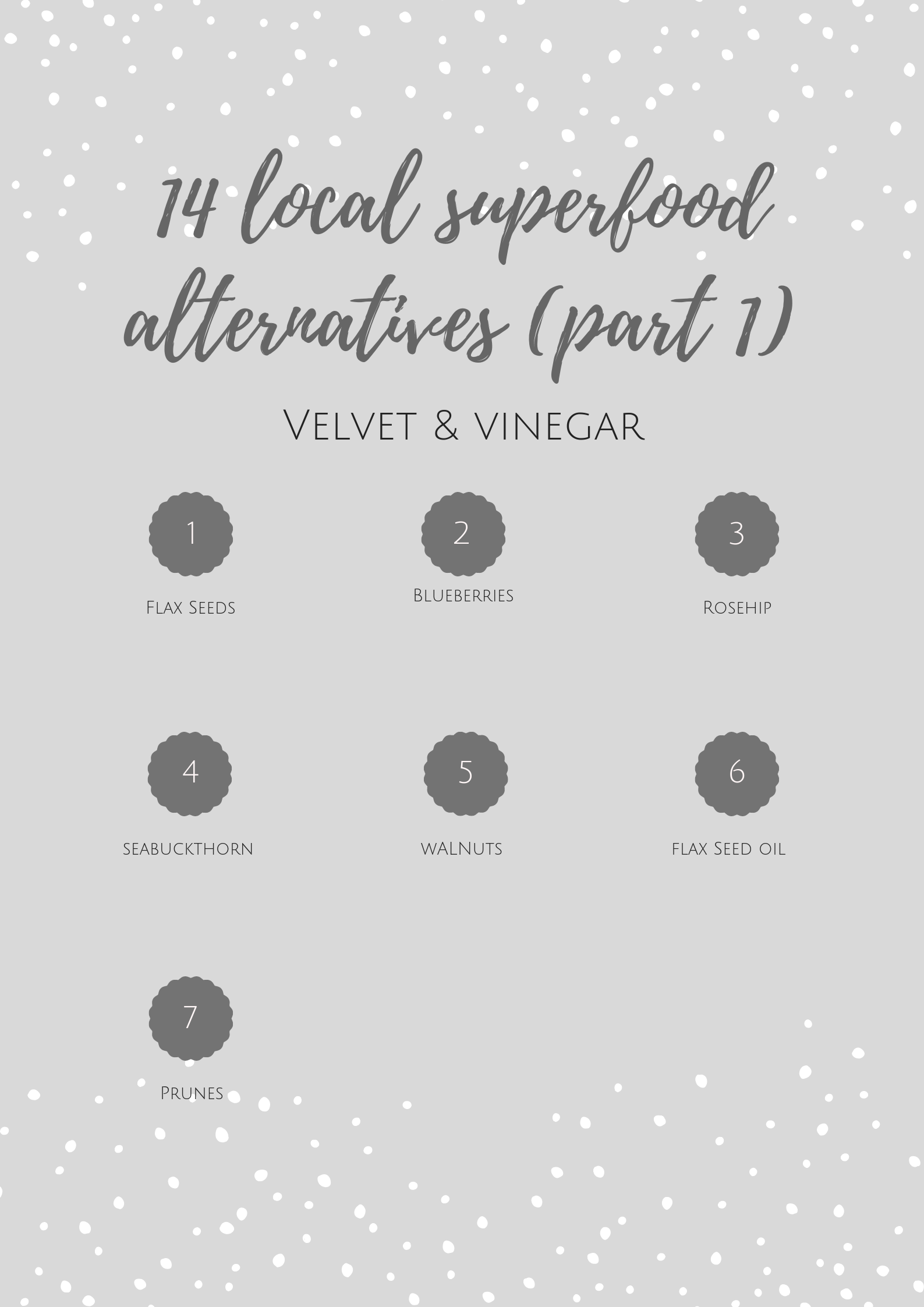This blog post is also available in German.
A few weeks ago we talked about the superfood hype and its sustainability. Sure, superfoods are an enrichment on our menu. But today I want to show you that there are many regional alternatives. These are just as healthy and way more sustainable. As an example, I`ll show you 14 local alternatives for exotic superfoods. If you want a detailed list, download my free ebook. I also only use local alternatives for exotic superfoods for the recipes of this ebook.
First of all, a balanced and wholesome diet with lots of local seasonal vegetables and fruits can replace any exotic superfood.
1. Açai berries
The Açai berries (Euterpe oleracea) are from South America. They grow in the Amazon and are a staple food for the rainforest inhabitants. The berries are very healthy, especially because of their antioxidant effect. They`re also said to lower cholesterol levels, promote blood circulation and have anti-aging effects.
Açai berries are perishable goods. This is why they`re mainly available in processed form (puree, powder). On the other hand you always get regional berries in fresh condition as long as they are in season. Local alternatives to exotic superfoods are always preferable as they`re fresher and thus more nutritious. In addition, açai products may contain additives or impurities that you should avoid, depending on quality and degree of processing.
main ingredients: Antioxidants in the form of anthocyanins, vitamins A, C, various B vitamins & E, unsaturated fatty acids (especially linoleic & oleic acids), essential amino acids (proteins), calcium, potassium, iron, phosphorus, magnesium, zinc and copper.
local alternatives: Blueberries (they contain more antioxidants than açai berries), local purple vegetables & fruits (all contain anthocyanins), black currants, chokeberries or other native berries, walnuts & flaxseed oil (as an alternative to fatty acids).
2. Acerola
The same applies to the acerola cherry (Malpighia glabra) from Central and South America. It`s also not available fresh in our latitudes. The red cherries are said to have an immune-strengthening, antioxidant and cholesterol-lowering effect. The former is due to their high vitamin C content.
main ingredients: Antioxidants, high vitamin C content, vitamins A, B1 and B2, niacin, iron, phosphorus, calcium and proteins.
local alternatives: Rosehip & sea buckthorn are equal suppliers of vitamin C.
3. Avocado
Besides açai, chia and quinoa, avocado (Persea americana) is one of the most hyped exotic superfoods. The tropical fruit is famous for its healthy fats. It`s also said to have a positive effect on elevated cholesterol levels. Wrong? No! On critical examination, however, one quickly notices that there are enough equivalent local alternatives. And in view of their water consumption, the illegal clearing of forests, the establishment of harmful monocultures and the deprivation of a staple food for the local population, everyone should ask themselves whether the consumption of avocados is still justifiable.
main ingredients: unsaturated fatty acids
local alternatives: Walnuts, hemp, flaxseed and canola oil.
4. Chia seeds
Chia seeds (Salvia hispanica) grows from Mexico to Ecuador and is experiencing a boom since several years already. They are popular, not only with those who want to eat healthy, but also amongst the vegan community. Chia seeds are a great egg alternative for baking. They`re supposed to stimulate the digestion, strengthen the nerves, promote the blood circulation, lower the cholesterol level and blood pressure and are a very substantial ingredient.
However, their allergy potential and blood thinning effect must be taken into consideration. People with blood thinners or antihypertensives should check their values when taking chia seeds.
main ingredients: rich in omega-3 fatty acids, proteins, fiber, antioxidants, vitamins A, B1, B2, B3 & E, calcium (6x more than whole milk), phosphorus, manganese, magnesium (15x more than broccoli), iron (3x more than spinach).
local alternatives: flaxseeds contains more omega-3 fatty acids & just as much fibre, stinging nettle seeds or hemp seeds are just as good protein suppliers.
5. Dates
Dates (Phoenix dactylifera) enjoys great popularity not only among raw food lovers. This is mainly due to the fact that they`re a healthy sugar substitute. In addition, the superfruits, which are widespread from North Africa to Afghanistan, are great energy suppliers and rich in fibre. This is why they stimulate digestion and have a high nutrient content.
You should consume dates moderately though. In addition to natural sugar, dates clearly contain lots of calories. You can read more about this topic here.
main ingredients: vitamin C & E, B vitamins, iron, potassium, magnesium & calcium, fibre.
local alternatives: Prunes also contain B vitamins, vitamin C, E & additional vitamin A, as well as calcium, magnesium, iron and potassium and fibre. However, always pay attention to origin & do not consume too many of them as they have a laxative effect.
6. Goji berries
Goji berries (Lycium barbarum) from Asia, mainly China, are sold as dried berries. They are supposed to strengthen the immune system and prevent cardiovascular diseases. Their vitamin C and iron content is remarkable.
However, studies of the berries show that they`re heavily contaminated with pesticides. Therefore, always pay attention to organic quality. Goji berries also have a certain allergy potential and have a blood-thinning effects. People with blood thinners should therefore always consult their pharmacist or doctor before consuming goji berries. There is also a certain risk of confusion between goji berries and similar species.
You can also plant goji berries yourself if you can`t live without them.
main ingredients: high vitamin C content, essential amino acids, iron (11mg/100g), B vitamins, antioxidants, calcium (800mg/100g) and other minerals and trace elements (21 in total).
local alternatives: for vitamin C rose hip & sea buckthorn. For iron stinging nettle, parsley, oats, millet, legumes or beetroot. For calcium nuts, legumes, kale, any other type of cabbage, broccoli. Antoxidants are present in green vegetables, carrots, pumpkins, berries.
7. Pomegranate
The pomegranate (Punica granatum) is an absolute superfruit. It originates in the Mediterranean region and usually comes from Spain, Turkey, Israel or Egypt. The red fruit is said to have an anti-aging effect due to its antioxidants. As well as slimming, cell-protective, anti-inflammatory, vascular-protective, cholesterol-lowering and anti-carcinogenic effects (possibly with prostate cancer) are said. A true miracle weapon!
main ingredients: Antioxidants due to the the pomegranate polyphenols, B vitamins, vitamin C & E, folic acid, biotin & beta carotene, potassium, calcium & iron.
local alternatives: pumpkin seeds have a positive effect on the prostate. Calcium is provided by broccoli, arugula, cress, kale and green cabbage. Potassium from berries (especially currants), cabbage, mushrooms, green leafy vegetables & herbs, potatoes and pumpkin seeds. You can get iron from beetroot, stinging nettles and legumes.
8. Ginger & Turmeric
These two superfood bombs are now also available locally. Just the week before I bought fresh ginger at the farmers market. You can also plant both of them yourself without any problems.
9. Coconut & Coconut oil
A superfood as critical as avocado. Especially the coconut oil obtained from the tropical coconuts (Cocos nucifera) is very popular. Coconuts, as well as the oil, have antimicrobial properties, which is why they are often used for oil pulling and in cosmetics. The oil is also ideal as an alternative to chemical face creams or make-up remover products. The coconut is also said to have a cholesterol- and blood sugar-lowering, as well as immune-strengthening effect.
The fact is that 90% of coconut oil consists of saturated fatty acids. And therefore it`s not as healthy as it`s advertised. In moderate quantities the consumption is justifiable. Many people with skin diseases have phenomenal results with the external use of coconut oil. Don`t confuse coconut oil with coconut fat though. Coconut fat is highly refined and contains harmful trans fats. When buying coconut oil, always pay attention to cold pressing method, because refined oil contains practically no vitamins (especially vitamin E).
However, with regard to sustainability, we should question the consumption of coconuts and their oil. Coconut palms require more land for cultivation for a lower field compared to the palm oil representative. They`re therefore not a sustainable alternative to palm oil. In addition, the coconut hype promotes the illegal clearing of rainforests.
main ingredients: saturated fatty acids, magnesium, calcium, potassium, iron, phosphorus, copper, sodium, essential amino acids, vitamin E.
local alternatives: regional oils such as canola, hemp or flaxseed oil, which contain a better omega-3 to omega-6 ratio and are much more sustainable.
10. Matcha
Matcha powder is a product from green tea (Camellia sinensis) and usually comes from Japan or China. The green powder is very popular as an alternative to coffee. The waking effect is similar to coffee, but lasts longer (4 to 6 hours). In addition, the ceremonial aspect of drinking Matcha has a calming and stress-reducing effect. The catechins in the powder stimulate the metabolism. The essential amino acids have a calming effect. The contained chlorophyll is considered healthy. Matcha is also said to lower cholesterol and blood pressure.
As matcha tea also contains caffeine you should consume it moderately. In addition, it contains oxalic acid and is therefore not suitable for people with kidney stones or increased risk for kidney stones. Those who drink the green powder should always drink enough water.
main ingredients: Antioxidants, catechins, vitamin A, B, C & E
local alternatives: lavender, camomile, valerian, hop and lemon balm teas are just as calming. Dandelion tea stimulates metabolism and digestion. Chlorophyll also is present in regional green leafy vegetables.
11. Moringa
I regularly receive enquiries at the pharmacy about this plant from Southeast Asia and Africa. Moringa has lots of miraculous effects. It has an anti-aging effect due to the hormone zeatin it contains. Moringa also has positive effects on the intestines and liver and stimulates the detoxification functions of the body. It also has a calming effect and lowers blood pressure and cholesterol. However the study situation is rather sparse. In my opinion, their content of essential amino acids and antioxidants makes the plant particularly remarkable.
When taking Moringa, you sould consider the following; don`t take moringa during pregnancy. In addition, due to pollution, you should chose organic products. The roots and bark of the miracle tree can contain toxic alkaloids, which can be harmful especially in high doses. I would also advise against the consumption of extracts. Diabetics, blood pressure patients and people with thyroid diseases should contact their doctor or pharmacist before taking moringa or check their values regularly.
main ingredients: essential amino acids, antioxidants, zeantine (youth hormone), iron, magnesium, potassium, calcium, zinc, fatty acids, vitamins A, B, C, E & folic acid.
local alternatives: you can also get essential amino acids via nuts, soy and legumes. Zinc can be found in oatmeal & legumes. Vitamin E in sunflower seeds, pumpkin seeds or nuts. Vitamin A & C in green vegetables, rose hips or sea buckthorn. Folic acid in green leafy vegetables.
12. Papaya
Surely you saw the tasty papaya boats (Carica papaya), which were all over the internet? The fruit flown in from the tropics has positive effects on digestion, especially stomach problems and inflammation. It also has an anti-inflammatory and immune-enhancing effect. The enzyme papain helps with sore throats and hoarseness.
main ingredients: Vitamins A, B & especially C, fibre, magnesium, zinc, potassium, calcium, sodium & iron, antioxidants.
local alternatives: actually already listed above. Vitamin C from rose hip or sea buckthorn. Local vegetables and fruits, as well as legumes replace a papaya without problems.
13. Quinoa
Quinoa (Chenopodium quinoa), a superfood from the Andes region. The pseudo-grain is not only popular because it`s gluten-free, but also because it`s rich in fibre and protein. This makes quinoa an excellent source of plant protein. The only disadvantage, the increased demand led to massive planting of monocultures with alarming effects on nature. As well as price increases with fatal effects on the Andean population, whose basic food it is. If you can`t live without quinoa, find out if there are regional producers. For example Switzerland grows quinoa.
main ingredients: proteins, dietary fibres, trace elements (manganese, potassium, iron, calcium), B vitaminsl
local alternatives: Millet is a protein alternative; it contains almost as much protein as quinoa. Depending on the source, millet (also gluten-free) is an equivalent iron alternative, otherwise oats or additional vegetables. Oats have minimally less magnesium & calcium, but this can also be compensated with local vegetables.
14. Raw Cocoa
Cocoa (Theobroma cacao) not only tastes delicious, but in the form of raw cocoa it`s also incredibly healthy. Raw cocoa contains more iron than meat and more antioxidants than green tea and blueberries. It also promotes blood circulation, prevents cardiovascular diseases and regulates blood pressure. When buying cocoa, however, always make sure that it`s raw and hasn`t been further processed, otherwise it loses many of its important nutrients.
The consumption of cocoa and chocolate is unfortunately a little clouded, not only in terms of sustainability (it comes from exotic regions), but also because on the cocoa plantations in Africa where child labor is present. In addition, rainforest is cleared for cocoa plantations and the farmers are exploited. Therefore at least pay attention to organic quality and fairtrade seals.
main ingredients: Antioxidants (more than green tea), magnesium, iron, potassium, calcium, zinc, vitamin E, unsaturated fatty acids, fibre.
local alternatives: the alternatives already mentioned above already. Swiss chard contains comparable amounts of magnesium.
In summary:
With a balanced, wholesome and healthy diet, you don’t need exotic superfoods. I would also like to point out that some very well-known superfoods, such as sauerkraut or kale, are not on the list here. They`re already regional. There`s a detailed list of local alternatives for exotic superfoods in my ebook.
For the sake of completeness, some of the superfood effects mentioned above are based on insufficient scientific evidence. Nevertheless, I believe that a colourful diet with unprocessed foods such as vegetables, fruits, seeds, nuts, legumes, etc. has a positive effect on the general condition as well certain diseases (cardiovascular, diabetes & cholesterol). However, there are enough local alternatives for exotic superfoods. Which is why, in my opinion, you should mostly stick to local produce.
The information listed here is based on intensive research. As well as the knowledge of 5 years of studies in pharmaceutical sciences. I`ve spent several hours looking into all the local alternatives for exotic superfoods and comparing their ingredients.
If you have any questions, feel free to contact me directly. The best way is via email or leave me a comment below this article.
Read you soon
Sarah




